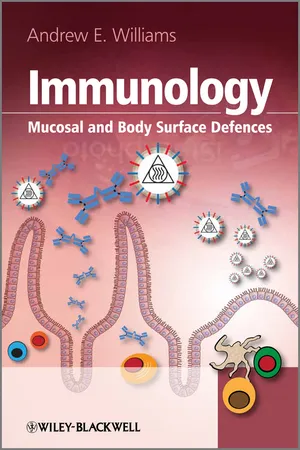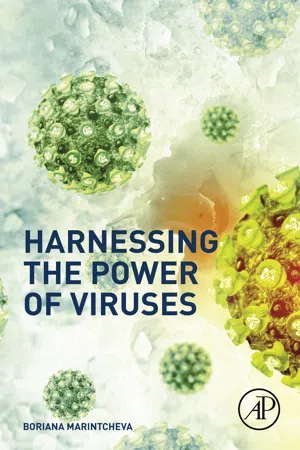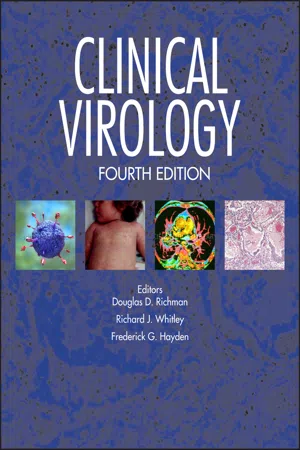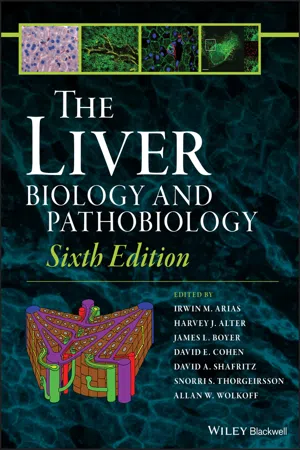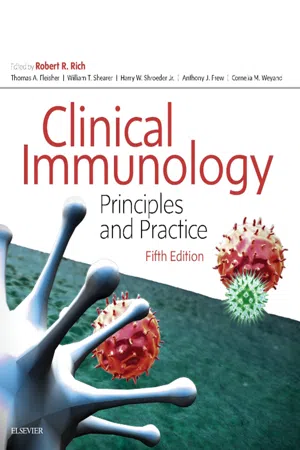Biological Sciences
Viral Immune Escape
Viral immune escape refers to the ability of viruses to evade the host's immune response, allowing them to persist and replicate in the body. This can occur through various mechanisms, such as mutations in viral proteins that are targeted by the immune system, or by inhibiting the host's immune response. Viral immune escape poses a challenge for the development of effective vaccines and antiviral therapies.
Written by Perlego with AI-assistance
Related key terms
Related key terms
1 of 4
Related key terms
1 of 3
7 Key excerpts on "Viral Immune Escape"
- eBook - ePub
Immunology
Mucosal and Body Surface Defences
- Andrew E. Williams(Author)
- 2011(Publication Date)
- Wiley(Publisher)
On the other hand, non-cytopathic viruses tend to cause little direct damage to the host and result in persistent infection. Non-cytopathic viruses are more adept at avoiding the effects of neutralizing antibodies; therefore CTL responses become more important in order to control persistent infection, although subsequent immune-mediated tissue damage may result. In addition, it has proven much more difficult to vaccinate against non-cytopathic viruses, due to the lack of a neutralizing antibody responses. Non-cytopathic viruses have evolved ways to avoid the effects of neutralizing antibody in order to promote chronic persistence.11.20 Immune Evasion by Antigenic Shift and DriftImmunological memory provides effective protection against subsequent encounter with the same virus. For example, neutralizing antibodies directed against viral epitopes prevent secondary infection across mucosal tissues. However, certain viruses are able to escape immune detection by antibodies by establishing mutant viruses that have altered antigenic determinants. This process in known as antigenic drift, whereby viral mutants acquire small changes to their nucleotide sequence that result in changes to surface proteins. In addition, large scale changes can also occur when whole gene segments are swapped between different strains of the same virus (Box 11.2). This is thought to occur when two separate strains of virus infect the same host cell and genetic re-assortment takes place. This process is known as antigen shift and can result in the emergence of completely new strains of virus. Influenza virus best exemplifies these processes. Variations between the same strains of seasonal influenza virus occur following the process of antigen drift, which results in slight variations in haemagglutinin and neuraminidase antigenic determinants. The emergence of new pandemic strains of influenza occur following antigenic shift, which is characterized by a completely new combination of haemagglutinin and neuraminidase proteins.Box 11.2. Influenza Viruses and Flu Epidemics. - No longer available |Learn more
- Phoebe Lostroh(Author)
- 2019(Publication Date)
- Garland Science(Publisher)
antigenic variation , which is variation in the amino acids (primary sequence) of an antigenic protein. During viral replication, missense mutations occur that cause offspring virions to express slightly different proteins compared with the virus that first infected the person. Because in many cases one amino acid can substitute for another without altering the function of a protein, these variations usually do not affect viral replication directly. A small change in the primary sequence of an antigen can have profound effects on the immune response, however, because even a single amino acid change in one epitope compared to a second epitope can prevent antibodies from binding to the altered antigen. Thanks to antigenic variation, when the immune system mounts a response against epitopes derived from an original infecting population of virions, some of the mutant offspring virions escape detection because their epitopes are just different enough.Antigenic variation is particularly important for two groups of viruses. The first group is composed of species that can cause new lytic infections in people, even if those people survived and controlled a previous infection by that same species of virus. Prominent examples include influenza and rhinovirus. There are more than 100 antigenically distinct rhinoviruses, so that a person can catch the common cold, caused by an antigenically distinct rhinovirus each time, many times in a lifetime. In this case the immune reaction that cured the person of rhinovirus number 77 will prevent future infections with rhinovirus number 77 but not from rhinovirus number 38, and so on. Similarly, antigenic variation is critical for the success of influenza as a pathogen and has dramatic impacts on vaccination (see Chapter 16 ), epidemics, and pandemics (see Chapter 17 ).The second group of viruses in which antigenic variation is particularly important is that of viruses that cause persistent lytic infections so that they must escape an infected person’s immune response for many years. Human immunodeficiency virus (HIV) provides a prominent example. During an HIV infection, viral replication is ongoing so that large populations of new virions are constantly being produced even as the immune system works to control the infection. In response to selection from the immune system, viral epitopes evolve and eventually the adaptive immune response is not able to control viral replication: the virus is said to escape from the immune response. Uncontrolled HIV replication ultimately causes HIV’s preferred lymphocyte host cells to die and permits the onset of AIDS. - eBook - ePub
- Boriana Marintcheva(Author)
- 2017(Publication Date)
- Academic Press(Publisher)
Chapter 8Viruses as Tools for Vaccine Development
Abstract
Vaccines are considered one of the greatest advancements in the field of public health in the modern world. Vaccination programs worldwide are saving lives and preventing debilitating diseases and disabilities. As science advances, viruses are gaining a new status in the field of vaccines. They are no longer considered solely as pathogens whose action is a target of vaccine development. Instead, slowly but surely, viruses are starting to be seen as a source of a diverse array of molecular tools that can be utilized toward vaccine development and modulation of the immune system. This chapter provides a short overview of human immune response, types of vaccines, and new technologies related to vaccination strategies and using vaccination principles to design immunological solutions of major health challenges.Keywords
Antibodies; Immune response; Immunological memory; Preventive vaccines; Therapeutic vaccines8.1. The Aerial View of the Human Immune System
The human immune system is a complex entity in our body defending us against pathogens. In essence, it employs a continuous surveillance of molecules circulating throughout the organism and uses self versus foreign triage to identify substances presenting a threat to our health. Once foreign invaders are identified, the immune system deploys an army of diverse tools to neutralize them. The human immune response is incredibly complex and swiftly adapts to meet the challenges of each day of our lives.Figuratively, one can view the immune system as a dynamic collection of cells, tissues, organs, and processes working together to prevent disease. The immune system targets microorganisms (bacteria, viruses, protozoa), parasitic worms, toxins, allergens, and even our own cells when they display unusual characteristics. Since pathogens evolve constantly, the immune system is equipped to deal with an enormous diversity of antigens (broadly defined as any entity that triggers immune response) and to adapt quickly. Essentially, every molecule can be an antigen; however, science has figured out that proteins and carbohydrates elicit the strongest response, whereas nucleic acids and lipids are very poor antigens. The immune response is a highly coordinated and layered process that progresses from employing physical means to producing chemical and cellular tools with an increasing level of specificity. As a result, the invading pathogen is destroyed and the body acquires long-term protection and immunological memory ensuring prompt response to future encounters with the same antigen. The immune response is often described by: (1) contrasting the innate and acquired components (Fig. 8.1 - eBook - ePub
- Barry R. Bloom, Barry R. Bloom, Paul-Henri Lambert(Authors)
- 2002(Publication Date)
- Academic Press(Publisher)
37 ], and other intracellular parasites, are usually controlled initially by T cells.II. THE ROLES OF EARLY EVENTS AND PARASITE VARIABILITY IN HOST–PARASITE RELATIONSHIPS
Most cytopathic agents leave little leeway between death and survival. In contrast, a wide range of relationships is possible between low or noncytopathic infections and the host. Many parameters, such as interferon production and susceptibility of the infection to interferons, influence this equilibrium. In addition, mutation rates of the pathogens play a major role. Variability of antigens permits infectious agents to escape T cells or neutralizing antibodies, in the individual as well as at the population level. The variability of the parasite genome plays a major role in these selections. Selection of mutations is driven by epidemiological forces, either in the whole population, such as antigenic drift and shift in acute influenza viruses, or within an individual host for persistent viruses, such as HBV and possibly HIV or LCMV in mice. Therefore, RNA viruses that have an error-prone genome are particularly variable and can escape host immune responses efficiently. The games between absolute numbers of infectious agents, mutation frequencies, and efficiency of defense influence the subtle overall balance that results in either early efficient control [e.g., asymptomatic tuberculosis (TB), short-term HBV infection, asymptomatic long-term survivors of HIV infection] or chronic immunopathological disease that may evolve over a long time (e.g., organ-specific TB, AIDS, liver cirrhosis, perhaps diabetes type 2, some forms of arteriosclerosis and arthritis). Thus, early events set the stage and the equilibrum of host-parasite relationships that will determine the eventual outcome of slowly developing, immunopathologically mediated disease. Although this has become more obvious with a better understanding of HIV infections, other infections exhibit similarly vast spectra of differing diseases; this includes TB, leprosy, HBV, HCV (LCMV in mice), probably infections with coxsackie- or measles viruses [including subacute sclerosing panencephalitis (SSPE)], and most classical parasite infections. - eBook - ePub
- Douglas D. Richman, Richard J. Whitley, Frederick G. Hayden, Douglas D. Richman, Richard J. Whitley, Frederick G. Hayden, Douglas D. Richman, Richard J. Whitley, Frederick G. Hayden(Authors)
- 2016(Publication Date)
- ASM Press(Publisher)
Effective immunization safely induces a vaccine-specific host immune response capable of either preventing infection or attenuating illness. Historically, viral vaccine immunogens were created by either inactivating or attenuating whole virus and were tested empirically with a rudimentary understanding of basic viral pathogenesis or protective immune responses. Newer generations of viral vaccines often involve a detailed understanding of the virology and immunology specific to the pathogen and utilize molecular biology approaches to produce vaccine antigens. This chapter will review current viral vaccine practices and concepts and indicate future directions for vaccine research and development.GOALS OF VACCINATION
The goal of immunization against viruses is to improve both individual and public health by preventing or modifying virus-induced disease in a person and preventing or reducing the spread of infection in a population. When individuals do not participate in vaccination efforts against epidemic diseases, there are potential consequences for the person but greater consequences for public health (2 ). Vaccination is one of the few opportunities for a personal health benefit to be amplified as a benefit to the greater population.Prevention of Infection or Disease
Active and Passive Immunization
Immunization is defined as induction of an antigen-specific host immune response by exposing the host to antigens representing, or comprised of those in, the wild-type pathogen. “Active immunization” to a virus can be induced by natural infection or by vaccination. The term implies an induction of immunological memory. “Passive immunization” refers to a transfer of temporary immunity to the host, which will not provide immunologic memory, but provides transient immune-mediated protection from infection or disease. The most common example of passive immunization is the transfer of disease-specific immunoglobulins into a host (3 - eBook - ePub
The Liver
Biology and Pathobiology
- Irwin M. Arias, Harvey J. Alter, James L. Boyer, David E. Cohen, David A. Shafritz, Snorri S. Thorgeirsson, Allan W. Wolkoff(Authors)
- 2020(Publication Date)
- Wiley-Blackwell(Publisher)
The temporal association between viral evolution and antibody seroconversion corroborates the hypothesis of a selective pressure exerted by the humoral immune response on the viral population, leading to an increasingly complex quasispecies that can evade control by the adaptive immune system. This hypothesis is also supported by the lack of HVR1 genetic evolution in patients with agammaglobulinemia [ 194 ]. Besides antigenic variation, HCV can also protect itself against NAbs by other mechanisms, including direct cell‐to‐cell transmission [ 195 ], occlusion of conserved neutralization epitopes by variable regions such as the HVR1 [ 196, 197 ] or its extensive glycan shield [ 198 ], virion interaction with and even incorporation of protective lipoproteins [ 199, 200 ], and induction of interfering antibodies [ 201 ]. The variable contribution of multiple mechanisms of immune evasion in different patients may help to explain the often conflicting results obtained in different studies of NAb sensitivity and correlation with disease outcome. Elucidating the full spectrum of protective mechanisms enacted by HCV to escape immunologic control may provide critical knowledge for the development of a protective vaccine. In summary, despite intensive research over the past three decades, the role of humoral immune responses in the prevention, clearance, and long‐term control of HCV infection remains controversial. As a consequence, there is still uncertainty about the possibility of developing a vaccine capable of inducing protective antibodies - No longer available |Learn more
Clinical Immunology E-Book
Principles and Practice
- Robert R. Rich, Thomas A. Fleisher, William T. Shearer, Harry Schroeder, Anthony J. Frew, Cornelia M. Weyand(Authors)
- 2018(Publication Date)
- Elsevier(Publisher)
Because of MHC polymorphism, the peptides selected for protection, self tolerance, and autoimmunity will vary from one individual to the next. Many pathogens have developed specific proteins that degrade or interfere with the essential functions of the protein cofactors that regulate MHC-restricted antigen presentation. These viral evasions strategies allow the infected host cell to avoid immune recognition and destruction by CD8 and CD4 T cells. Interference with antigen presentation also leads to the escape of host cells from tumor-specific surveillance and allow progressive growth and metastases.We now understand many of the key players in MHC-restricted presentation of antigen to CD4 and CD8 T cells. In the future this understanding will be used for vaccine design strategies, and in personalized medicine aimed at enhancing immunosurveillance and protection mediated by the adaptive immune response.Acknowledgement
With the permission of authors J. Rodgers and R. Rich, the section of this chapter that discusses the nature of antigens was reproduced, with modification, from Chapter 6 of the 4th edition of Clinical Immunology: Principles and Practices.
Index pages curate the most relevant extracts from our library of academic textbooks. They’ve been created using an in-house natural language model (NLM), each adding context and meaning to key research topics.
Explore more topic indexes
Explore more topic indexes
1 of 6
Explore more topic indexes
1 of 4
